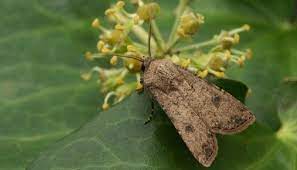The winter weevil is not a new pest in our fields
It causes the greatest damage to tomatoes, corn, legumes, sunflowers, sugar beets, and winter cereals. Can damage soybeans, peas, zucchini, potatoes, vegetables. Damage to grapes and tree saplings was noted. In general, the phytophagous caterpillar can feed on 50-120 types of plants. The pest develops in two generations. It hibernates in the stage of the caterpillar of the last age in the soil at the depth of the arable layer (10-25 cm). In the spring, they rise to the top layer of the soil, where they pupate. The summer of butterflies of the first generation begins in the third decade of May. Females lay eggs one at a time, sometimes 10-30 on the underside of leaves of thistle, field birch, quinoa, and other weeds. Under favorable conditions, one butterfly can lay up to 2,000 eggs. Young caterpillars feed on weed leaves, and starting from the third age, they damage cultivated plants. The butterflies of the second generation fly from mid-July to mid-September. Caterpillars of the second generation feed on weeds, winter seedlings, and potato tubers until October, and then climb into the deeper layers of the soil for the winter. Dry, hot weather is favorable for the development of winter snowdrop. The economic threshold of harmfulness for each culture is different and ranges from 1 to 8 caterpillars per 1 square meter.
It should be noted that agrotechnical measures are effective and efficient in limiting the number of scoops: proper soil cultivation, inter-row loosening of row and vegetable crops during the period of mass laying of eggs by butterflies or immediately after it ends, destruction of weeds, deep plowing of fields with a plow no later than mid-October (until the caterpillar leaves for wintering. Also, the use of trichogram is one of the safe measures against this pest. In Ukraine, there was a large network of laboratories that propagated these entomophagous insects. But now, unfortunately, the level of use of this measure is decreasing every time. You can use poisons, soil insecticides that act continuously throughout the sensitive period. When applying insecticides on crops, it is necessary to catch the moment for the insecticide to fall on the larva. Treatments are carried out in the evening, when the caterpillar feeds on plants, using Funanon 1.2 l/ha, Dynadim Stable 1.0-1.5 l/ha or other recommended insecticides according to the “List of pesticides and agrochemicals torturers authorized for use in Ukraine”.
When working with plant protection products, it is necessary to observe the generally accepted state sanitary rules of DSP 8.8.1 and the rules of personal hygiene.
G. Masynets, specialist of the department of control over the circulation of plant protection products

